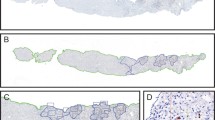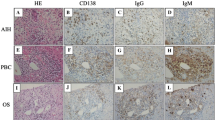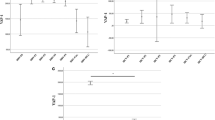Abstract
Purpose
This study aimed to clarify the role of complement activation in fibrogenesis in BA.
Methods
In total, 27 paraffin-embedded liver biopsy samples were immunohistochemically analyzed using C4d polyclonal antibody, vascular cell adhesion molecule-1 (VCAM-1), and CD45. The liver samples were obtained from 25 patients during Kasai operation, and two additional specimens were obtained from 2 patients by needle biopsy later at the time of liver function deterioration. The degree of liver fibrosis was histologically graded 1–3.
Results
Among the 25 samples, 9 showed C4d-positive immunostaining localized on the endothelia of a few portal veins in the portal tract. The degree of fibrosis was correlated with C4d staining (p = 0.025). The age at Kasai operation correlated with the degree of fibrosis and the C4d positivity. Two needle biopsy samples were positive for C4d. Among 13 samples submitted for VCAM-1 staining, 2 negative samples were C4d negative and all positive C4d samples were VCAM-1 positive with CD45 mononuclear cell infiltration.
Conclusion
These findings suggest that ongoing cirrhosis could be a result of progressive “vasculopathy” of the portal vein caused by humoral and cell-mediated immune interaction.




Similar content being viewed by others
References
Lykavieris P, Chardot C, Sokhn M, Gauthier F, Valayer J, Bernard O (2005) Outcome in adulthood of biliary atresia: a study of 63 patients who survived for over 20 years with their native liver. Hepatology 41:366–371
Nio M, Sasaki H, Wada M, Kazama T, Nishi K, Tanaka H (2010) Impact of age at Kasai operation on short- and long-term outcomes of type III biliary atresia at a single institution. J Pediatr Surg 45:2361–2363
Hadchouel M, Hugon RN, Odievre M (1981) Immunoglobulin deposits in the biliary remnants of extrahepatic biliary atresia: a study by immunoperoxidase staining in 128 infants. Histopathology 5:217–221
Sokol RJ, Mack C (2001) Etiopathogenesis of biliary atresia. Semin Liver Dis 21:517–524
Feldman AG, Mack CL (2012) Biliary atresia: cellular dynamics and immune dysregulation. Semin Pediatr Surg 21:192–200
Lu BR, Brindley SM, Tucker RM, Lambert CL, Mack CL (2010) α-Enolase autoantibodies cross-reactive to viral proteins in a mouse model of biliary atresia. Gastroenterology 139:1753–1761
Feucht HE, Felber E, Gokel MJ et al (1991) Vascular deposition of complement-split products in kidney allografts with cell-mediated rejection. Clin Exp Immunol 86:464–470
Stegall MD, Chedid MF, Cornell LD (2012) The role of complement on antibody-mediated rejection in kidney transplantation. Nat Rev Nephrol 8:670–678
Weerasooriya V, White FV, Shepherd RW (2004) Hepatic fibrosis and survival in biliary atresia. J Pediatr 144:123–125
Haga H, Egawa H, Fujimoto Y et al (2006) Acute humoral rejection and C4d immunostaining in ABO blood type-incompatible liver transplantation. Liver Transpl 12:457–464
Aguilera I, Sousa JM, Gavilan F et al (2011) Complement component 4d immunostaining in liver allografts of patients with de novo immune hepatitis. Liver Transpl 17:779–788
Bouron-Dal Soglio D, Rougemont AL, Herzog D et al (2008) An immunohistochemical evaluation of C4d deposition in pediatric inflammatory liver diseases. Hum Pathol 39:1103–1110
Dankof A, Schmeding M, Morawietz L et al (2005) Portal capillary C4d deposits and increased infiltration by macrophages indicate humorally mediated mechanisms in acute cellular liver allograft rejection. Virchows Arch 447:87–93
Schmeding M, Dnakof A, Krenn V et al (2006) C4d in acute rejection after liver transplantation—a valuable tool in differential diagnosis to hepatitis C recurrence. Am J Transpl 6:523–530
Kobayashi H, Horikoshi K, Long L et al (2001) Serum concentration of adhesion molecules in postoperative biliary atresia patients: relationship to disease activity and cirrhosis. J Pediatr Surg 36:1297–1301
Muraji T, Hosaka N, Irie N et al (2008) Maternal microchimerism in underlying pathogenesis of biliary atresia: quantification and phenotypes of maternal cells in the liver. Pediatrics 121:517–521
Parker C (2009) Eculizumab for paroxysmal nocturnal haemoglobinuria. Lancet 373:759–767
Author information
Authors and Affiliations
Corresponding author
Rights and permissions
About this article
Cite this article
Fujisawa, S., Muraji, T., Sakamoto, N. et al. Positive C4d staining of the portal vein endothelium in the liver of patients with biliary atresia: a role of humoral immunity in ongoing liver fibrosis. Pediatr Surg Int 30, 877–881 (2014). https://doi.org/10.1007/s00383-014-3553-3
Accepted:
Published:
Issue Date:
DOI: https://doi.org/10.1007/s00383-014-3553-3




